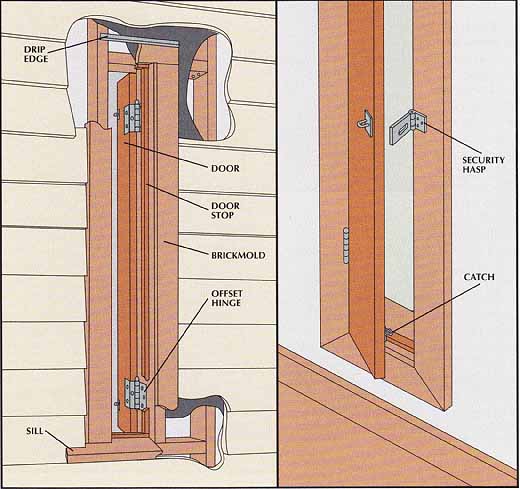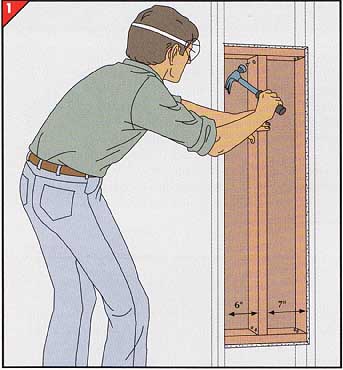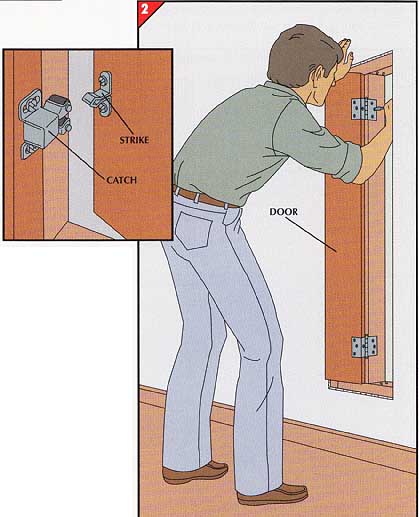For safety and convenience, you need a way to move materials in and out of the shop with ease. In some cases, you may be able to rearrange furniture, fixtures, and appliances to pro vide access. But often, the obstacle is an immovable part of the house—a projecting wall, a narrow doorway, or a winding staircase. Threading materials through your house in these circumstances is not only inconvenient—the exercise will also track dirt and dust through the house.
A Simple Slot: For a shop on the ground floor, you can frame an opening through an exterior wall. To accommodate unwieldy items such as 4-by-8 panels, the portal need only be
55 inches high and 6 to 8 inches wide. Locating the opening between two adjoining studs takes little carpentry skill and entails no risk to the structure of your house.
TOOLS:
- Electronic stud sensor
- Carpenter’s level
- Compass saw
- Circular saw
- Hammer
- Electric drill
- Screwdriver
- Nail set
- Paintbrush
- Caulking gun
MATERIALS:
- 2 x 4s
- Sill stock
- Shims
- Common nails (3½”)
- Plywood (3/4”)
- Offset hinges
- Door-stop molding
- Galvanized finishing nails (1½”, 2”, 2½”)
- Spring catches
- Security hasp
- Weather stripping
- Wallboard repair materials
- Molding
- Drip edge
- Paint
- Caulk
SAFETY TIPS: Wear goggles when nailing or operating power tools. Put on gloves and long sleeves when handling fiberglass insulation.
A vertical opening framed between adjoining studs can accommodate 4-by-8 panels and unwieldy pieces of lumber. The door is hung on i-inch offset hinges. Spring-action catches, screwed to the door and the stud on one side of the pass-through, keep the door shut; weather strip ping attached to the door stops blocks drafts. Casing is installed around the opening on the inside (near left). Outside, brickmold frames the sides and top; a drip edge is added at the top, and a sloping sill is installed along the bottom of the opening (far left). All exposed wood is painted, and caulk is applied where trim meets siding. A security hasp installed on the inside permits the door to be padlocked.
A Wall Slot for Plywood
• Turn off electrical power to the work area, then mark and cut an opening through the interior wall between two studs, starting 4 to 8 inches above the baseboard and extending 55 inches up the wall; take care not to cut into any wires. Remove insulation from the opening.
• Cut two 2-by-4s to fit between the studs. With 3 1/2-inch common nails, toenail the 2-by-4s to the studs across the top and bottom of the opening.
• Cut a third 2-by-4 to fit vertically between the first two boards, then toenail it in place 7 inches from one stud and 6 inches from the other .
• Drill a hole at each corner of the 7-inch slot through the exterior wall; then working outside, cut the opening defined by the drilled holes.
• To make the door, cut a piece of 3/4-inch plywood to fit inside the 7-inch-wide opening.
• Fasten two offset hinges to the door, then secure them to the vertical 2-by-4 .
• Close the door, then cut pieces of door-stop molding to fit around the sides and top. With 14-inch finishing nails, fasten the stops to the frame around the door.
• Cut a length of commercial sill stock 7 inches long plus the width of the pieces of brick- mold to be applied. Notch the sill at each end so it fits inside the 7-inch opening on top of the lower 2-by-4 and just touches the closed door. Shim it to slope toward the outside and fasten it to the 2-by-4 with 2½-inch finishing nails. Cut door-stop molding to run along the edge butting against the door, and fasten it in place.
• Mount two spring-action catches on the inside of the door near the free edge—one at the top and one at the bottom. Fasten the strikes to the door and the catches to the stop (inset). Then screw on a security hasp, and attach weather stripping to the door stops.
• Replace the insulation in the open half of the slot, then patch the opening with wallboard.
• Inside and out, frame the opening with molding fastened with 2-inch finishing nails, using wood strips to bring it flush with the walls if necessary. Outside add drip edge between the siding and the top piece of molding. Paint all the exposed wood and caulk the gaps between the siding and the molding.
Next: Soundproofing
the Shop
Prev: Adding an Exhaust Fan


